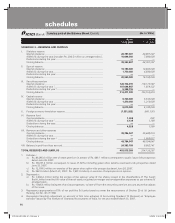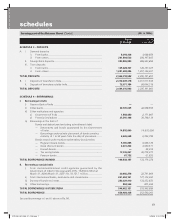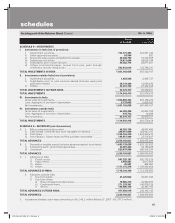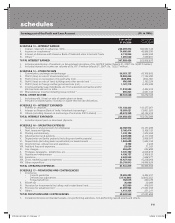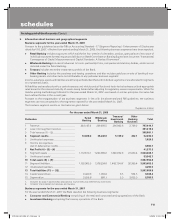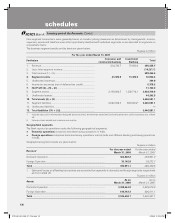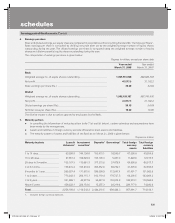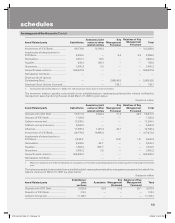ICICI Bank 2008 Annual Report Download - page 90
Download and view the complete annual report
Please find page 90 of the 2008 ICICI Bank annual report below. You can navigate through the pages in the report by either clicking on the pages listed below, or by using the keyword search tool below to find specific information within the annual report.
F16
10. Income Taxes
Income tax expense is the aggregate amount of current tax, deferred tax and fringe benefit tax borne by the Bank. The
income tax provision is determined in accordance with the provisions of the Income Tax Act, 1961. Deferred tax adjustments
comprise of changes in the deferred tax assets or liabilities during the period.
Deferred tax assets and liabilities are recognised on a prudent basis for the future tax consequences of timing differences
arising between the carrying values of assets and liabilities and their respective tax basis, and carry forward losses. Deferred
tax assets and liabilities are measured using tax rates and tax laws that have been enacted or substantively enacted at
the balance sheet date. The impact of changes in deferred tax assets and liabilities is recognised in the profit and loss
account.
Deferred tax assets are recognised and reassessed at each reporting date, based upon management’s judgement as to
whether their realisation is considered as reasonably certain.
11. Impairment of Assets
Fixed assets are reviewed for impairment whenever events or changes in circumstances indicate that the carrying amount
of an asset may not be recoverable. Recoverability of assets to be held and used is measured by a comparison of the
carrying amount of an asset with future net discounted cash flows expected to be generated by the asset. If such assets
are considered to be impaired, the impairment is recognised by debiting the profit and loss account and is measured as
the amount by which the carrying amount of the assets exceeds the fair value of the assets.
12. Provisions, contingent liabilities and contingent assets
The Bank estimates the probability of any loss that might be incurred on outcome of contingencies on the basis of information
available up to the date on which the financial statements are prepared. A provision is recognised when an enterprise has
a present obligation as a result of a past event and it is probable that an outflow of resources will be required to settle the
obligation, in respect of which a reliable estimate can be made. Provisions are determined based on management estimates
required to settle the obligation at the balance sheet date, supplemented by experience of similar transactions. These are
reviewed at each balance sheet date and adjusted to reflect the current management estimates. In cases where the available
information indicates that the loss on the contingency is reasonably possible but the amount of loss cannot be reasonably
estimated, a disclosure to this effect is made in the financial statements. In case of remote possibility neither provision nor
disclosure is made in the financial statements. The Bank does not account for or disclose contingent assets, if any.
13. Earnings per share (“EPS”)
Basic earnings per share is calculated by dividing the net profit or loss for the year attributable to equity shareholders by
the weighted average number of equity shares outstanding during the year.
Diluted earnings per share reflect the potential dilution that could occur if contracts to issue equity shares were exercised
or converted during the period. Diluted earnings per equity share is computed using the weighted average number of equity
shares and dilutive potential equity shares outstanding during the period, except where the results are anti-dilutive.
14. Lease transactions
Lease payments for assets taken on operating lease are recognised as an expense in the profit and loss account over the
lease term.
15. Cash and cash equivalents
Cash and cash equivalents include cash in hand, balances with RBI, balances with other banks and money at call and short
notice.
SCHEDULE 19
NOTES FORMING PART OF THE ACCOUNTS
The following additional disclosures have been made taking into account the requirements of accounting standards and
Reserve Bank of India (“RBI”) guidelines in this regard.
1. Merger of the Sangli Bank Limited
The Sangli Bank Limited (Sangli Bank), a banking company incorporated under the Companies Act, 1956 and licensed by
RBI under the Banking Regulation Act, 1949 was amalgamated with ICICI Bank with effect from April 19, 2007 in terms
of the Scheme of Amalgamation (the Scheme) approved by RBI vide its order DBOD No. PSBD 10268/16.01.128/2006-07
dated April 18, 2007 under section 44A(4) of the Banking Regulation Act, 1949. The consideration for the amalgamation
was 100 equity shares of ICICI Bank of the face value Rs. 10 each fully paid-up for every 925 equity shares of Rs. 10 each of
Sangli Bank. Accordingly on May 28, 2007, ICICI Bank allotted 3,455,008 equity shares of Rs. 10 each to the shareholders
of Sangli Bank.
As per the Scheme, the entire undertaking of Sangli Bank including all its assets and liabilities stood transferred/deemed
to be transferred to and vested in the Bank.
The amalgamation has been accounted as per the scheme in accordance with the purchase method of accounting as per
Accounting Standard 14 (AS-14) “Accounting for Amalgamations” issued by the Institute of Chartered Accountants of India.
Accordingly the assets and liabilities of Sangli Bank have been accounted at the values at which they were appearing in the
schedules
forming part of the Accounts (Contd.)
ICICI_BK_AR_2008_(F1_F46).indd 16ICICI_BK_AR_2008_(F1_F46).indd 16 6/20/08 3:24:42 PM6/20/08 3:24:42 PM


